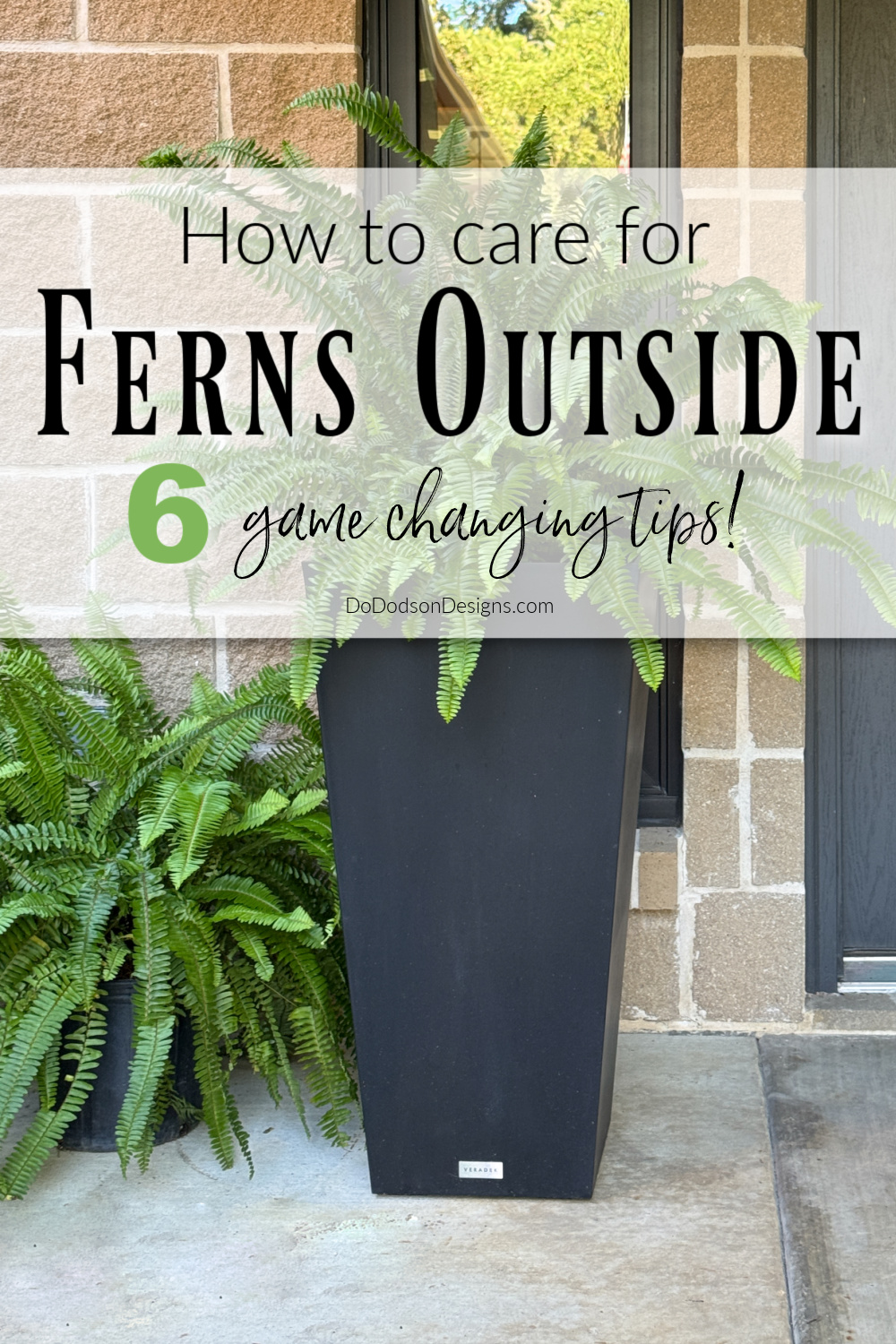
Hey friend, If you want to add some greenery to your front porch or outdoor patio space, ferns are a popular and beautiful choice. You, too, can have a green thumb and grow these amazing ferns in pots and baskets. In today’s post, learn everything you’ll need to know about outdoor fern care.
* As an Amazon Associate, I earn from qualifying purchases and through other companies as well. You will not be charged extra when you purchase through these affiliate links, but any income I make helps me create more amazing DIY projects to share with you! To see my full disclaimer, click here!
1. Selecting The Right Types Of Ferns For You
Selecting the right hardy ferns for your zone is the secret to growing and maintaining beautiful ferns throughout the growing season. Your success depends on your selection of fern and fern care.
With the exception of the cinnamon ferns in my woodland gardens, which live year-round, they go into survival mode in the cold months but emerge every Spring to show off.
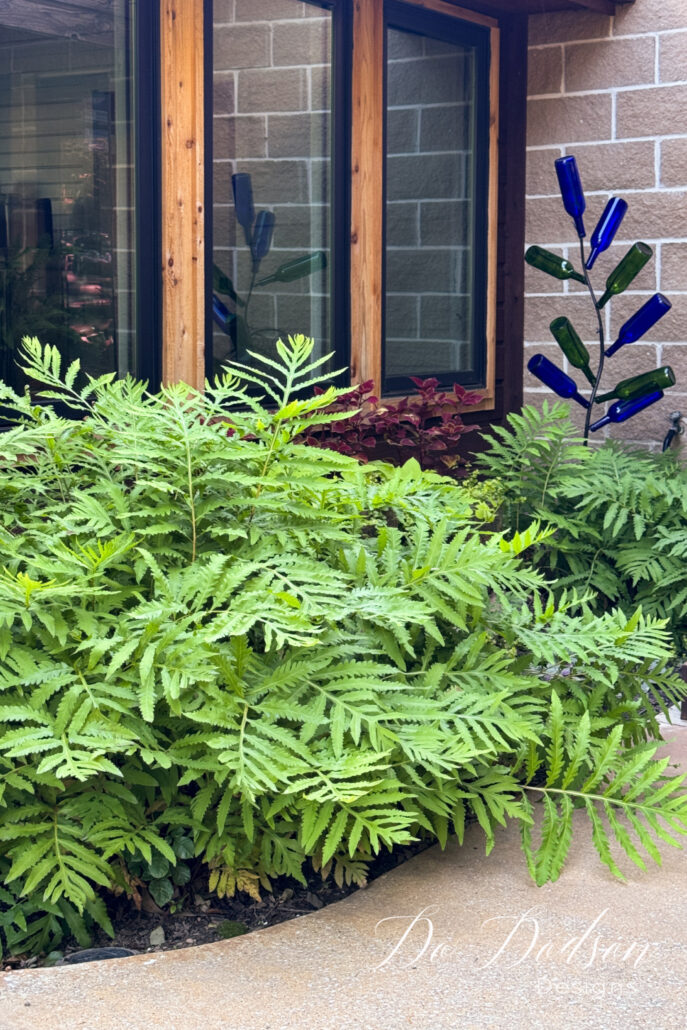
Most of the ferns I grow are seasonal in pots and baskets on the porch. Our zone (in Texas) is 8b.
Typically, the hardiness zoning guide refers to whether a plant can survive the colder temperatures over winter. However, it also determines whether the weather is too warm for plants to survive. This is our problem in Texas when growing outdoor ferns. It gets pretty dang hot here!
If you’re unsure of your growing zone where you live? CLICK HERE to find your zone in the US. Climate does matter!
My Favorite Ferns To Grow In Containers
a. Boston Ferns: These types of ferns can be grown indoors as houseplants or outdoors, but they do best outdoors in bright, full shade during the warmer months. They will tolerate a bit of morning sun, but not much. With their lovely green drooping fronds, these perennials are best grown in zones 9-11 but can be grown outdoors in pots in many zones during the warmer months.
CLICK HERE for more care instructions for Boston Ferns.
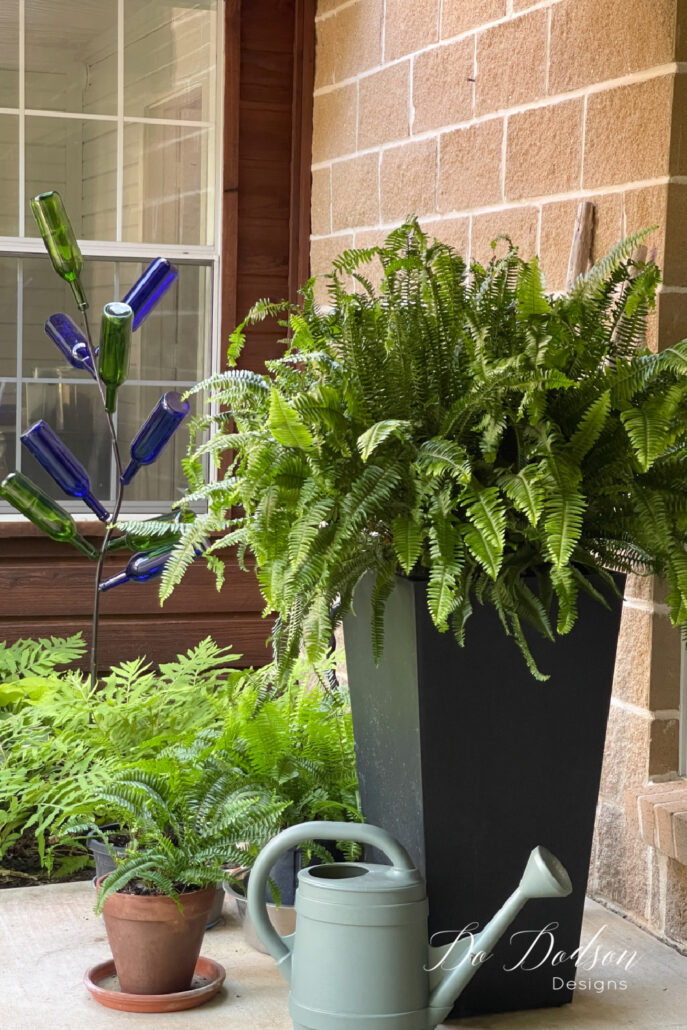
b. Kimberly Queen Ferns: These are my all-time favorite stand-up and take-notice fern. These lush green sword-shaped fronds look particularly beautiful in a tall plant stand. Unlike the Boston fern, the fronds are more upright. I display mine beside our front door entrance to add visual height. They will tolerate a bit of morning direct sunlight but mostly shade or a bright, shady spot, making them perfect for an east-exposure front porch with morning sun. Dapple sun through a high canopy tree is a good option. Ferns love the tiny bits of sun on their delicate fronds.
CLICK HERE for more care instructions for the Kimberly Queen fern.
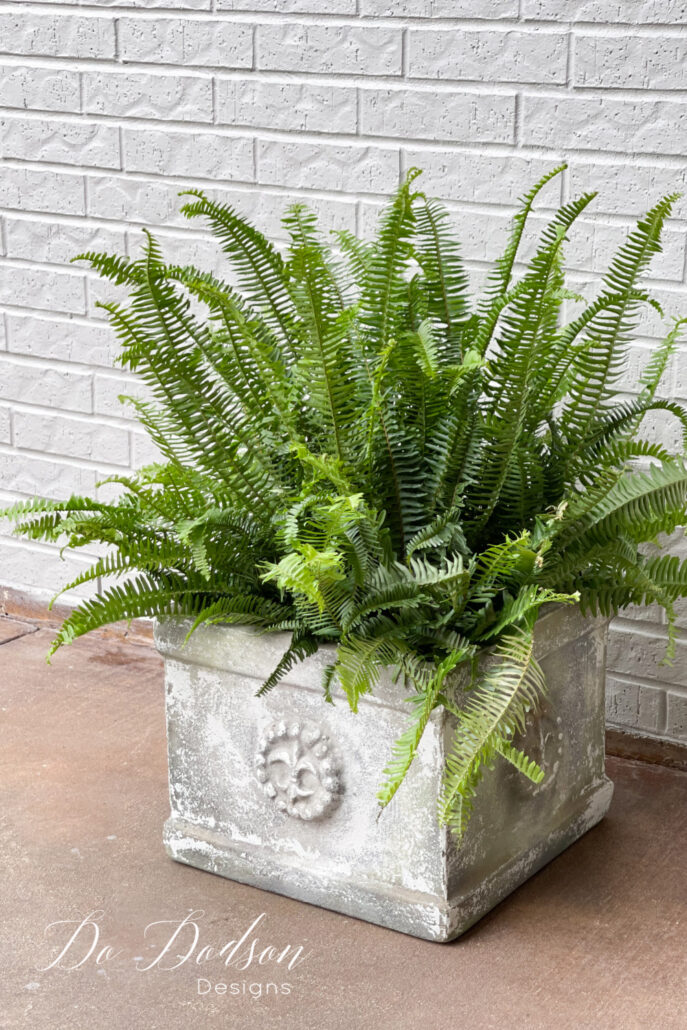
c. Macho Ferns (sword fern): These are the newest additions to my fern family, and I am obsessed with their foliage! They are called macho ferns because of their magnificent size. When in the right environment, they can grow up to 4 feet tall and 6 feet wide. They are native to Florida and Louisiana but do well in other warm areas.
Macho ferns will grow year-round in zones 9-10 and do well in hanging baskets. But be sure you have plenty of room for them. They love humidity and heat!
This was last Summer’s macho fern. It was huge!
CLICK HERE for more care instructions for the Macho Fern.
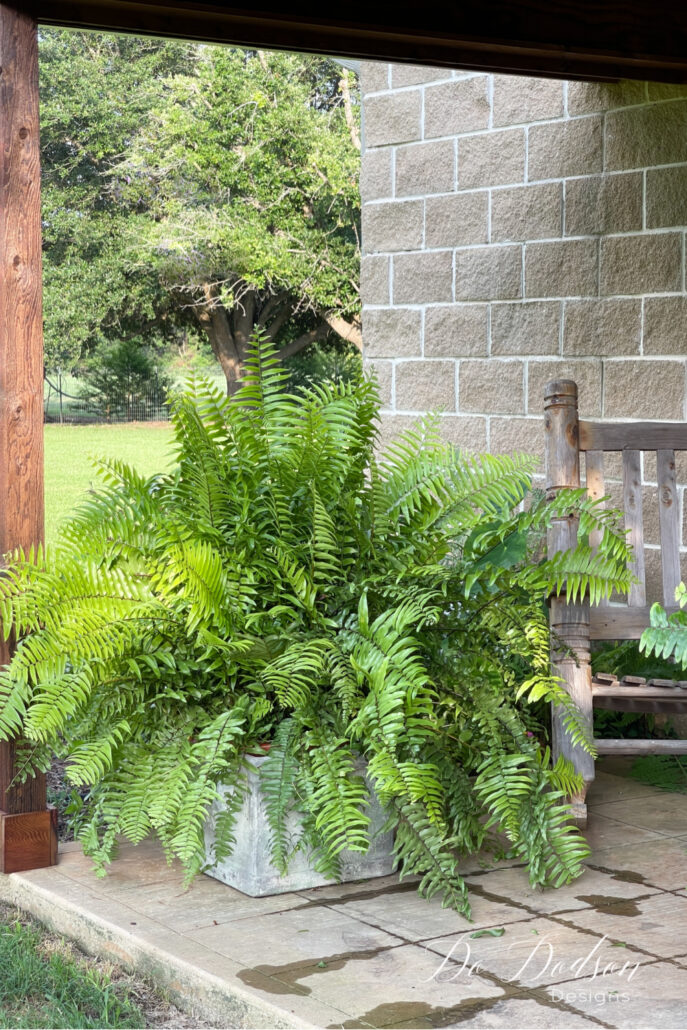
2. The Best Exposure For Your Hardy Fern
Research before you purchase a fern. Here is what you’ll need to consider for outdoor fern care.
- What is the location where you want your fern to live?
- Is it shady enough?
- Will it have bright, indirect light?
- Will the fern be exposed to the sun?
- If it does, how much sun and from which direction?
- How long will it get sun?
Most outdoor ferns will tolerate some morning sun but never full sun. I call it gentle sun. You’ll know right away if it’s too much. The delicate leaves will show signs of distress and turn yellow. Move it to another location with less sun.
Covered patios and shady porches are wonderful places for ferns to live. Be mindful that too much shade isn’t good either. Find a bright spot away from the sun that will allow your fern to thrive.
Always read the care instructions tags on your ferns before purchasing, but be wary. They can be misleading. Some big box stores (starting with a W) are notorious for mislabeling when selling plants.
EXAMPLE: Part sun to partial shade. What does that even mean? It doesn’t give you everything you need to consider. When I read these labels, I have a whole lot of questions.
3. How To Water Ferns In Pots and Hanging Baskets
First and foremost, no matter your fern selection, it will need well-draining pots or baskets. Ferns typically don’t like soggy feet, so drainage holes in the containers and a good soil mix are necessary. When purchased from the nursery, most ferns come in a lightweight plastic container with sufficient drainage holes.
In my honest opinion, these are the best containers. If you plan to move your fern to a prettier container, I suggest you find a larger pot size and slide the original plastic pot with the fern inside, leaving it in the original plastic container where it was grown. These containers allow watering and fertilizing from the underside or bottom of the pot. Ferns need consistent moisture to do well.
CLICK HERE to learn how I water ferns outdoors in these plastic containers.
4. Fertilizing Ferns With Epsom Salts
I know what you’re thinking. Salt?! Doesn’t that kill a plant? Not the salt.
I have been using the trick for the last few years, and it has made a world of difference in my ferns.
You can also use a slow-release fertilizer in addition to these monthly feedings. To learn more about fertilizing your ferns with Epsom salts, CLICK HERE.
5. Moisture And Watering Schedules
Moisture control and watering schedules are critical parts of outdoor fern care. Your ferns will thrive in moist soil and a humid environment. I cringe at the thought of Summers in Texas, but the humidity makes the perfect environment for fern lovers.
For a hanging basket in the heat of the Summer, you may need to water daily or twice daily. It all depends on the temperatures where you are. Ferns have a dense root system and are grown in well-drained soil. This means less dirt and more roots in your containers. No worries, ferns love their roots being close. It’s like a tight-knit family.
Just like they need moist soil, they do not like to stand in water. This could cause root rot.
6. Inspect Your Ferns Regularly For Pests and Insects
As part of your outdoor fern care, it’s always good to inspect your plants regularly. While ferns aren’t typically invaded by pests, it never hurts to do this quick check.
If you notice something unusual, like tiny insects or eggs, gently spray them away with a garden hose.
I have found a bird’s nest or two in my day. I’m always happy to give them a safe home. 🙂
While you’re there, observe the foliage. Your once bright green leaves may have turned dull green, indicating possible sun damage. Move to a new location.
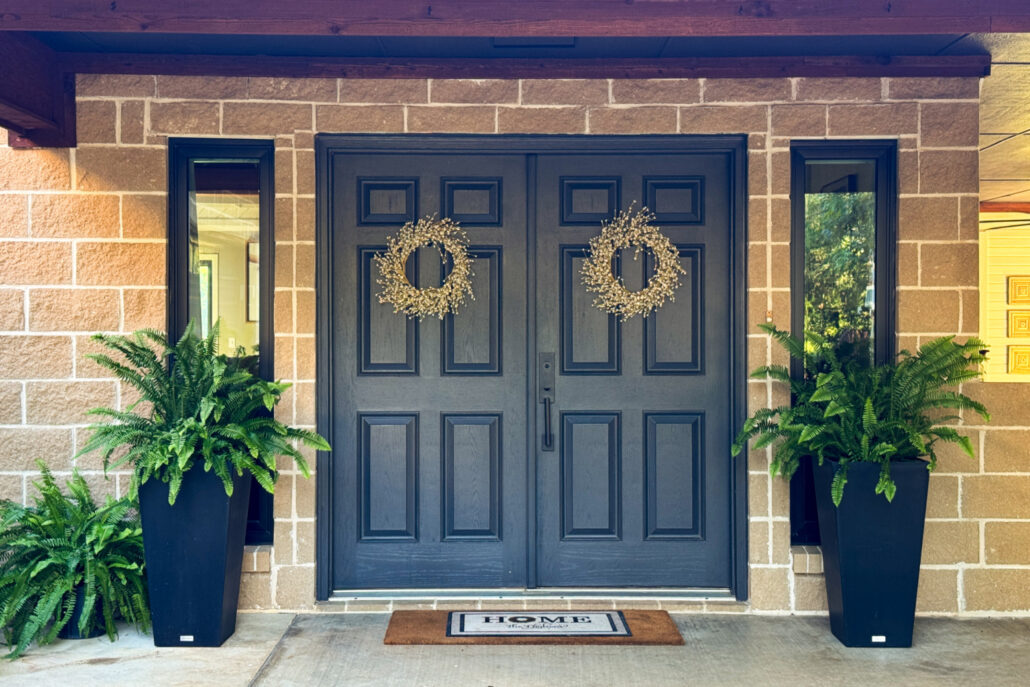
For more gardening tips and tricks, here are a few more articles I wrote that you might enjoy.
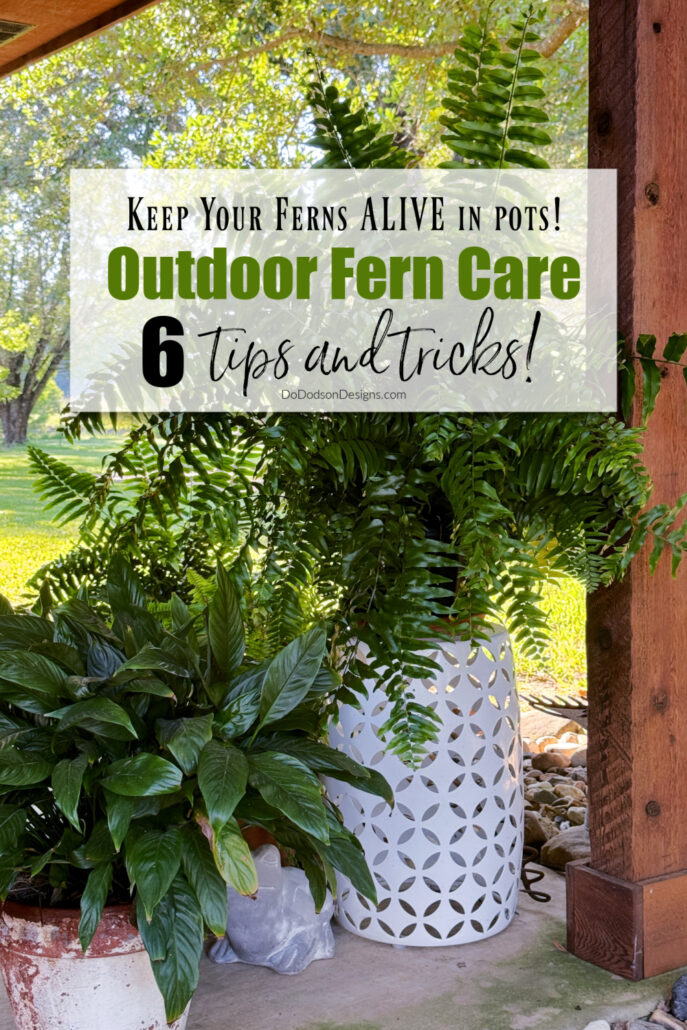
Outdoor fern care is pretty straight-forward once you find the perfect spot for your ferns.
I hope you found this article helpful. If I missed anything or you have other questions about the care of your outdoor ferns I didn’t cover; please leave me a message in the comment section. I’ll be more than happy to help you.
Gardening has recently become my second therapy after DIY projects. 🙂 Have a great week!
Until the next project… xo, Do


Your ferns are gorgeous Do! I have several on my shaded front porch and back patio. Thanks for you tips!
Hey Cindy! Thanks for reading. I’m having fun watching them grow. Life is good. Take care my friend. xo Do